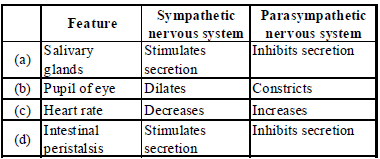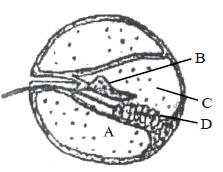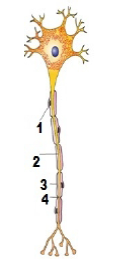Please see Chapter 21 Neural Control and Coordination Exam Questions Class 11 Biology below. These important questions with solutions have been prepared based on the latest examination guidelines and syllabus issued by CBSE, NCERT, and KVS. We have provided Class 11 Biology Exam Questions and answers for all chapters in your NCERT Book for Class 11 Biology. These solved problems for The Living World in Class 11 Biology will help you to score more marks in upcoming examinations.
Exam Questions Chapter 21 Neural Control and Coordination Class 11 Biology
Objective Questions
Question. Mechanism of vision includes following pathway in random order
A. Neural impulses are analysed and image formed on retina is recognised by visual cortex
B. Membrane permeability changes
C. Ganglion cells are excited
D. Bipolar cells are depolarised
E. Action potentials (impulse) are transmitted by optic nerves to visual cortex
F. Potential differences are generated in the photoreceptor cells
G. Light energy causes a change in shape of rhodopsin, leading to the dissociation of retinal (an aldehyde of vitamin A) from opsin ( a protein)
H. structure of opsin is changed
The correct sequence is
(a) A,B,C,D,E,F,G,H
(b) H,G,F,E,D,C,B,A
(c) A,D,C,B,G,H,F,E
(d) G,H,B,F,D,C,E,A
Answer
D
Question. What is meant by a reflex arc in the nervous system?
(a) An inherited behaviour pattern that functions through a certain neural pathway
(b) A functional unit consisting of a receptor, neural pathway, and an effector
(c) Peripheral nerves, spinal cords and brain
(d) A homeostatic system of sensory nerves, synapses and motor nerves
Answer
B
Question. A stimulus is received by a receptor, which initiates an impulse in the afferent neuron. The afferent neuron transmits the signal via____ nerve root into _____ (at the level of spinal cord). The efferent neuron then carries signal from _____ to the _____
(a) Ventral, CNS, PNS, sensory organs
(b) Ventral, CNS,CNS, effector
(c) Dorsal, CNS, PNS, affector
(d) Dorsal, CNS, CNS, effector
Answer
D
Question. Our paired eyes are located in sockets of skull called
(a) Sclera
(b) Fovea
(c) Retina
(d) Orbits
Answer
D
Question. Cornea is transparent part of
(a) Retina
(b) Choroid
(c) Sclera
(d) Conjuctive
Answer
C
Question. Match the following structures of human eye with their respective functions?
| Column – I | Column – II |
| A. Cornea | I. Provides opening for light to enter |
| B. Iris | II. Transduces blue, green and red light |
| C. Lens | III. Control the amount of light that enters |
| D. Optic nerves | IV. Alters the shape of lens |
| E. Pupil | V. Transmit information to the CNS |
| F. Ciliary muscles | VI. Focus light directly on retina |
| G. Fovea | VII. Bends light and protects inner eye |
Options :
(A) A – VII, B – III, C – VI, D – V, E – I, F – IV, G – III
(B) A – I, B – II, C – III, D – IV, E – V, F – VI, G – VII
(C) A – VII, B – VI, C – V, D – IV, E – III, F – II, G – I
(D) A – VII, B – II, C – III, D – V, E – I, F – III, G – II
Answer
A
Question. Iris is a part of
(a) Retina only
(b) Choroid only
(c) Sclera only
(d) Cornea only
Answer
B
Question. Three layers of cells in retina from inside to outside are
(a) Layers of ganglion cells, bipolar cells, photoreceptor cells
(b) Layers of ganglion cells, photoreceptor cells, bipolar cells
(c) Layers of photoreceptor cells, ganglion cells, bipolar cells
(d) Layers of bipolar cells, photoreceptor cells, ganglion cells
Answer
A
Question. Sensitive pigmented layer of eye is
(a) Retina
(b) Cornea
(c) Sclera
(d) None of these
Answer
A
Question. The area of retina in human eye containing only cone cells is called
(a) Pecten
(b) Tapetum
(c) Macula lutea
(d) Fovea centralis
Answer
D
Question. Which of the following statement is correct?
(a) Rods contain a purplish-red protein called rhodopsin\visual purple
(b) Rhodopsin is a derivative of vitamin A
(c) The twilight (scoptopic) vision is a function of rods
(d) All
Answer
D
Question. Following structures are given
A. Lens
B. Aqueous humour
C. Vitreous humour
D. Cornea
Choose the correct sequence of pathway of light from outside to inside the eyeball
(a) D,B,A,C
(b) A,B,C,D
(c) D,C,B,A
(d) A,D,B,C
Answer
A
Question. Which of the following is not a part of forebrain?
(a) Cerebrum
(b) Thalamus
(c) Hypothalamus
(d) Cerebellum
Answer
D
Question. Which of the following statement is incorrect about cortex of cerebrum?
(a) Its consists of grey matter
(b) It consists of white matter
(c) It shows prominent folds
(d) It contains motor areas, sensory areas, and association areas
Answer
B
Question. The medulla of cerebrum, inner part of cerebral hemisphere consists of
(a) Grey matter
(b) White matter
(c) Both grey and white matter
(d) Non myelinated nerve fibres
Answer
C
Question. The cerebrum wraps around a structure called thalamus which is
(a) A major coordination centre for sensory signal only
(b) A major centre for motor signalling
(c) A major coordinating centre for sensory and motor signalling
(d) Not a nervous part of brain
Answer
C
Question. The inner parts of cerebral hemispheres and a group of associated deep structures like amygdala, form a complex structure called
(a) Reticular system
(b) Corpora quadrigemina
(c) Limbic lobe\limbic system
(d) Arbor vitae
Answer
C
Question. Which the following statements or structures is not correct about the midbrain?
(a) Located between the thalamus\hypothalamus and pons
(b) Has arbor vitae
(c) Has a canal (Cerebral aqueduct)
(d) Its dorsal part consists of 4 lobes (corpora quadrigemina)
Answer
B
Question. Which of the following features is not related with pons?
(a) It forms floor of brain stem
(b) It serves as neural link between different parts of brain
(c) It can moderate the functions of respiratory rhythm centre
(d) It has a chemosensitive area for respiratory regulation
Answer
D
Question. Immediate involuntary response to stimulus is
(a) Reflex action
(b) Autonomic response
(c) Action control
(d) None of these
Answer
A
Question. Reflex is controlled by
(a) Spinal cord
(b) ANS
(c) PNS
(d) Sympathetic nervous system
Answer A
A
Question. Different components of reflex are given below
A. Effector organ
B. Interneuron
C. Motor neuron
D. Sensory neuron
E. Sensory receptor
Choose the correct order an action potential follows after a sensory receptor is stimulated-
(a) E,D,C,B,A
(b) E,D,B,C,A
(c) E,C,D,A,B
(d) E,B,D,C
Answer
B
Question. The controlling centre of autonomic nervous system is
(a) hypothalamus
(b) spinal cord
(c) cerebellum
(d) pons
Answer
A
Question. Sodium – Postassium pump across membrane, actively transports
(a) 2 Na ions outwards and 3 K ions into the cell.
(b) 3 Na ions outwards and 2 K ions into the cell.
(c) 2 K ions outwards and 3 Na ions into the cell.
(d) 3 K ions outwards and 2 Na ions into the cell.
Answer
B
Question. In the axons, the nerve impulse travels.
(a) towards the cell body.
(b) away from the cell body.
(c) away from synapse.
(d) in both direction.
Answer
B
Question. During recovery, a nerve fibre becomes
(a) positively charged outside and negatively charged inside.
(b) positively charged on both-outside and inside.
(c) negatively charged outside and positively charged inside.
(d) negatively charged on both-outside and inside.
Answer
A
Question. During rest, sodium pump of a nerve results in
(a) more Na+ pumped out than K+ ions taken in.
(b) Na+ pumped in without exchange with any other ion.
(c) exchanging equal amounts of Na+ and K+.
(d) more Na+ being pumped in than K+ ions pumped out.
Answer
A
Question. The transmission of impulse through neurons is a
(a) physical phenomenon
(b) chemical phenomenon
(c) electro-chemical phenomenon
(d) gravitational phenomenon
Answer
C
Question. The cerebral cortex is
(a) the outer layer of cerebrum, called white matter.
(b) inner layer of cerebrum, called white matter.
(c) the outer layer of cerebrum, called grey matter.
(d) inner layer of cerebrum, called grey matter.
Answer
C
Question. Centre for sense of smell is
(a) cerebellum
(b) olfactory lobes
(c) pons
(d) midbrain
Answer
B
Statement Type Questions
Question. Which of the following statement is correct regarding the organ of sight-eye?
(a) The space between cornea and lens is filled with transparent gel.
(b) When all cones are stimulated equally, a sensation of no light (dark) is produced.
(c) Rhodopsin is purplish red protein, hence called visual purple.
(d) The anterior transparent portion of choroid is called cornea.
Answer
C
Question. Which of the following statement is correct regarding cerebellum of brain?
(a) It is concerned with the maintenance of posture/ equilibrium.
(b) It is responsible for olfactory functions.
(c) It controls optic functions.
(d) both (a) and (c)
Answer
A
Question. Identify the main functions of the cerebrum of human brain from the given statement.
(i) Control the contraction of voluntary muscles through the frontal lobe.
(ii) Control the sensitivity, movement, memory, vocabulary etc. through the frontal lobe.
(iii) Control the temperature, taste, touch, pain etc. through the parietal lobe.
(iv) Control the hearing and sense of smell through the occipital and frontal lobes.
(a) (i), (ii), (iv)
(b) (i) (iii), (iv)
(c) (i), (ii), (iii)
(d) (ii), (iii), (iv)
Answer
C
Question. All are None law (principle) states that
(a) all stimuli produce action potentials.
(b) any cell membrane can generate and propagate an action potential if stimulated to threshold value.
(c) potential difference can either be 0 or 100.
(d) the property of action potential is independent of the strength of depolarizing stimulus.
Answer
D
Question. Which of the following statements are correct?
(i) Somatic nervous system- Conducts impulses from CNS to skeletal muscles.
(ii) Autonomic nervous system- Conduct impulses from CNS to internal organ muscles.
(iii) Central nervous system- Consists of brain and spinal cord
(iv) Peripheral nervous system- Consists of nerves carrying impulses to brain and spinal cord only
(a) Only (ii) and (iii)
(b) Only (iii) and (iv)
(c) Only (i), (ii) and (iii)
(d) All of these
Answer
C
Question. Which of the following events is involved in the transfer of information across a chemical synapse?
(i) Neurotransmitters bind to the postsynaptic receptors.
(ii) Calcium channels open in the presynaptic region.
(iii) Ion channels open in the postsynaptic membrane.
(iv) Direct flow of ions from one neuron to the next.
(a) (i) and (ii) only
(b) (i), (ii) and (iii) only
(c) (ii), (iii) and (iv) only
(d) All of the above
Answer
B
Question. Which of the following statements is correct?
(a) The internal ear receives sound waves and directs them to the ear drum.
(b) The membranous canals are suspended in the endolymph of the bony canals.
(c) The ear ossicles increase the efficiency of transmission of sound waves to the inner ear.
(d) The malleus is attached to the oval window and the stapes is attached to the temporal membrane of the cochlea.
Answer
C
Diagram Type Questions
Question. Given below is a table comparing the effects of sympathetic and parasympathetic nervous system for four features (a – d). Which of the following feature is correctly described?

Answer
B
Question. Given below is a diagrammatic cross section of a single loop of human cochlea with few part labelled as A, B, C & D.

Which one of the following options correctly represents the name of three different parts?
(a) A: Perilymph, B: Tectorial membrane C: Endolymph
(b) B: Tectorial membrane, C:Perilymph, D: Secretory cells
(c) C: Endolymph, D: Sensory hair cells, A: Serum
(d) D: Sensory hair cells, A: Endolymph B: Tectorial membrane
Answer
A
Question. The given diagram shows different parts of a human eye with one part labeled as X.

Which of the following statement is correct regarding label X?
(a) It is the opening in lens that permits light into the inner chambers of the eye.
(b) It is the coloured portion of vascular tunic.
(c) It is a biconcave structure that changes shape to bring objects into focus.
(d) It is thick, jelly-like substance in the posterior compartment of the eye.
Answer
B
Question. What is the function of label X in the given diagram?

(a) It speeds up the impulse transmission.
(b) It provides electrical insulation.
(c) It conducts impulse towards the nerve cell body.
(d) It is the functional unit of nerve.
Answer
A
Question. Identify the correct options for the given blanks.
Part of the ear Functions
_____A_____ Contains receptors for balance
_____B_____ Increases the magnitude of vibrations
_____C_____ Collects sound waves
(a) A- Semi-circular canals, B- Ear ossicles, C- Pinna
(b) A- Cochlea, B- Semi-circular canals, C- Tympanum
(c) A- Semi-circular canals, B- Cochlea, C- Tympanum
(d) A- Cochlea, B- Pinna, C- Ear ossicles
Answer
A
Question. The given diagram represents the sectional view of cochlea with few part labelled as I, II, III & IV.

The movement of which marked label causes hair cell microvilli to bend back and forth.
(a) I
(b) II
(c) III
(d) IV
Answer
D
Direction for Questions : Refer the given figure of neuron structure with few parts labelled as 1, 2, 3, and 4 and answer the questions.

Question. Identify the name and the labelled part which is a naked portion of myelinated axon and facilitate the rapid conduction of nerve impulses.
(a) Dendrites, 1
(b) Schwan cell, 2
(c) Synaptic knob, 3
(d) Nodes of Ranvier, 4
Answer
D
Question. Refer the given figure which shows the axon terminal and synapse with their parts marked as 1 to 7. Identify the correct parts whose constitution forms the structure of synapse.

(a) 1, 2, 3
(b) 3, 4, 5
(c) 4, 5, 6
(d) 5, 6, 7
Answer
C
Question. “X” is spiral shaped structure consisting of hair cells that serve as receptors for auditory stimuli. Identify “X” and its label & location (marked as 1, 2, 3 and 4) from the given diagrammatic representation of the sectional view of cochlea.

(a) X- Organ of corti, 2, 3.
(b) X- Eustachian tube, 1, 2.
(c) X- Semicircular canal, 3, 4.
(d) X- Crista ampullaris, 1, 4.
Answer
A
Critical Thinking Type Questions
Question. In which animal nerve cell is present but brain is absent?
(a) Sponge
(b) Earthworm
(c) Cockroach
(d) Hydra
Answer
D
Question. The main cause of paralysis is
(a) some defect in muscles
(b) complete destruction of motor nerves
(c) complete destruction of sensory nerves
(d) none of the above
Answer
B
Question. In a nerve if sodium pump is blocked, which of the following is most likely to happen ?
(a) Na+ and K+ will increases outside the cell.
(b) Na+ outside the nerve will increase.
(c) Na+ inside the nerve will increase.
(d) K+ inside the nerve will increase.
Answer
C
Question. An axon has four terminal ends connected with dendrites of four different neurons. Its nerve impulse will.
(a) become weak due to distribution into four.
(b) travel in all the four neurons with equal strength.
(c) pass on to one neuron only.
(d) travel to none because the movement of impulse is from dendrite to axon.
Answer
B
Question. Which of these is an example of conditioned reflex?
(a) Watering of mouth at the taste of food.
(b) Withdrawal of hand on touching a hot plate.
(c) Cycling.
(d) Flowing of tears while peeling and cutting onions.
Answer
C
Question. During the transmission of nerve impulse through a nerve fibre , the potential on the inner side of the plasma membrane has which type of electric charge?
(a) First positive, then negative and again back to positive.
(b) First negative, then positive and again back to negative.
(c) First positive, then negative and continue to be negative.
(d) First negative, then positive and continue to be positive.
Answer
B
Question. Identify the correct order in which vibrations travel through the auditory ossicles?
(a) Stapes-Malleus-Incus
(b) Malleus-Incus-Stapes
(c) Stapes-Incus-Malleus
(d) Incus-Stapes-Malleus
Answer
B
Question. Cornea transplantation is successful as cornea is
(a) easily available
(b) without blood supply
(c) easily preserved
(d) easily stitched
Answer
B
Question. In a similarity with photographic camera the retina acts as
(a) shutter
(b) lens
(c) diaphragm
(d) film
Answer
D